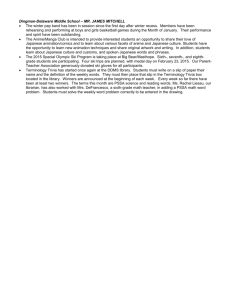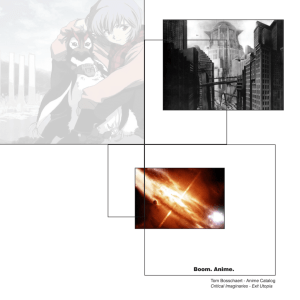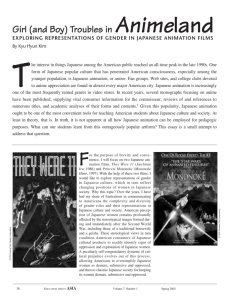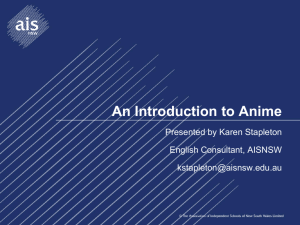Special Topics: Psychology of Film: Anime Archetypes (PSY
advertisement
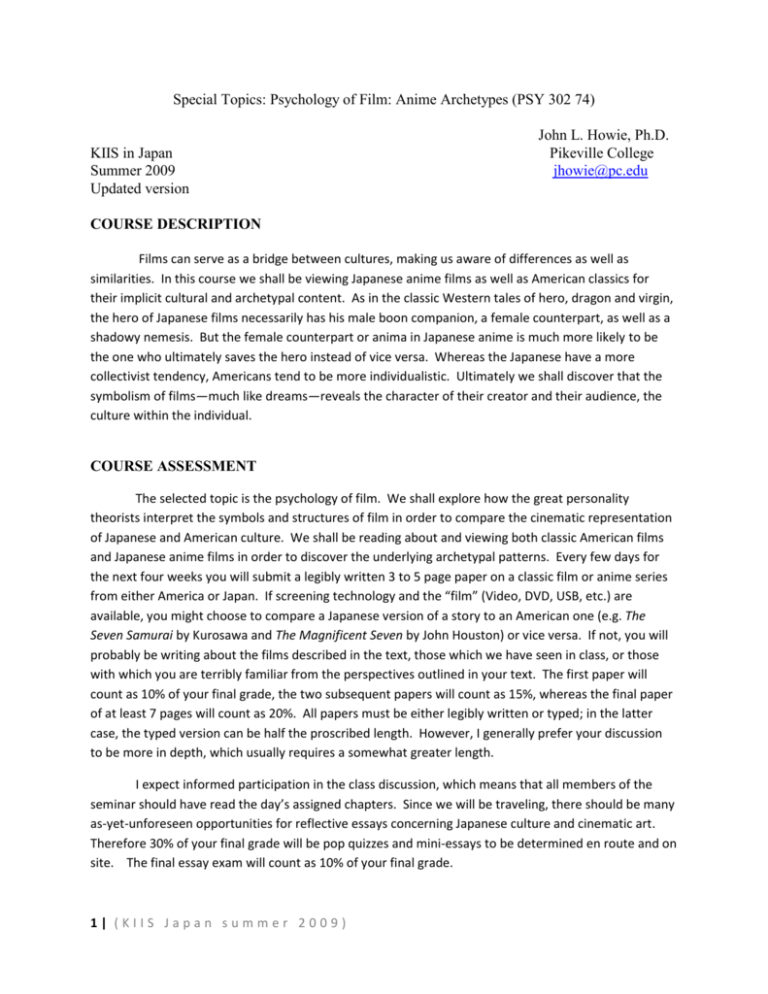
Special Topics: Psychology of Film: Anime Archetypes (PSY 302 74) KIIS in Japan Summer 2009 Updated version John L. Howie, Ph.D. Pikeville College jhowie@pc.edu COURSE DESCRIPTION Films can serve as a bridge between cultures, making us aware of differences as well as similarities. In this course we shall be viewing Japanese anime films as well as American classics for their implicit cultural and archetypal content. As in the classic Western tales of hero, dragon and virgin, the hero of Japanese films necessarily has his male boon companion, a female counterpart, as well as a shadowy nemesis. But the female counterpart or anima in Japanese anime is much more likely to be the one who ultimately saves the hero instead of vice versa. Whereas the Japanese have a more collectivist tendency, Americans tend to be more individualistic. Ultimately we shall discover that the symbolism of films—much like dreams—reveals the character of their creator and their audience, the culture within the individual. COURSE ASSESSMENT The selected topic is the psychology of film. We shall explore how the great personality theorists interpret the symbols and structures of film in order to compare the cinematic representation of Japanese and American culture. We shall be reading about and viewing both classic American films and Japanese anime films in order to discover the underlying archetypal patterns. Every few days for the next four weeks you will submit a legibly written 3 to 5 page paper on a classic film or anime series from either America or Japan. If screening technology and the “film” (Video, DVD, USB, etc.) are available, you might choose to compare a Japanese version of a story to an American one (e.g. The Seven Samurai by Kurosawa and The Magnificent Seven by John Houston) or vice versa. If not, you will probably be writing about the films described in the text, those which we have seen in class, or those with which you are terribly familiar from the perspectives outlined in your text. The first paper will count as 10% of your final grade, the two subsequent papers will count as 15%, whereas the final paper of at least 7 pages will count as 20%. All papers must be either legibly written or typed; in the latter case, the typed version can be half the proscribed length. However, I generally prefer your discussion to be more in depth, which usually requires a somewhat greater length. I expect informed participation in the class discussion, which means that all members of the seminar should have read the day’s assigned chapters. Since we will be traveling, there should be many as-yet-unforeseen opportunities for reflective essays concerning Japanese culture and cinematic art. Therefore 30% of your final grade will be pop quizzes and mini-essays to be determined en route and on site. The final essay exam will count as 10% of your final grade. 1| (KIIS Japan summer 2009) COURSE MATERIALS Movies and the Mind: Theories of the Great Psychoanalysts Applied to Film by William Indick; Jefferson, North Carolina: McFarland & Co., 2004. ISBN 10: 0786419539 Anime from Akira to Howl’s Moving Castle: Experiencing Contemporary Japanese Animation by Susan J. Napier; New York: Palgrave Macmilllan, 2005 (2nd Edition). ISBN 10: 1403970513 COURSE CALENDAR SESSION # DAY DATE READING Movies & the Mind Anime from Akira 1 2 3 4 Th Fr Sa Su June 4 June 5 June 6 June 7 5 6 7 Mo June 8 8 9 10 11 12 13 14 Tu We June 9 June 10 ASSIGNMENT Chapter 1 Chapter 2 Chapter 3 Chapter 4 Chapter 1 Chapter 2 Chapter 3 Chapter 4 Paper on Film Chapter 5 Chapter 6 Chapter 7 Chapter 5 Chapter 6 Chapter 7 Paper on Film TENRI - KYŌTO - TŌKYO - HIROSHIMA - NARA June 18 Chapter 8 Chapter 8 Chapter 9 Chapter 9 June 19 WEEKEND WITH HOST FAMILY Chapter 10 Mo June 22 Chapter 10 NARA – KYŌTO Chapter 11 Chapter 11 We June 24 Chapter 12 Th June 25 Chapter 12 Chapter 13 Chapter 13 Fr June 26 Conclusion Chapter 14 & Conclusion Su June 28 Th Fr 2| (KIIS Japan summer 2009) Paper on Film Final Paper on Film Final Essay Exam

